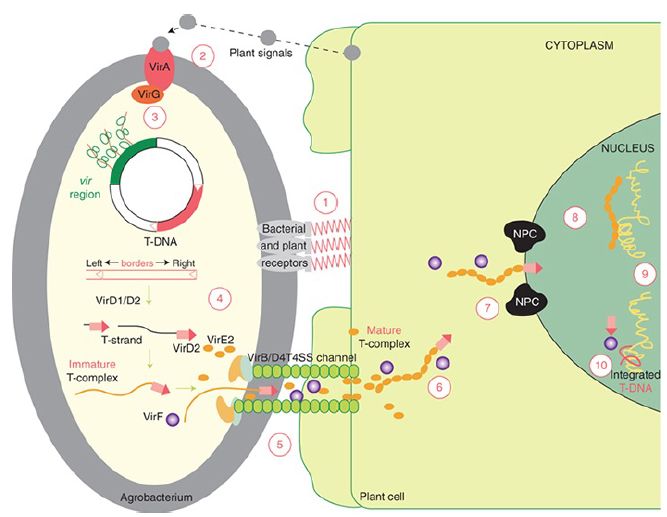

النبات

مواضيع عامة في علم النبات

الجذور - السيقان - الأوراق

النباتات الوعائية واللاوعائية

البذور (مغطاة البذور - عاريات البذور)

الطحالب

النباتات الطبية


الحيوان

مواضيع عامة في علم الحيوان

علم التشريح

التنوع الإحيائي

البايلوجيا الخلوية


الأحياء المجهرية

البكتيريا

الفطريات

الطفيليات

الفايروسات


علم الأمراض

الاورام

الامراض الوراثية

الامراض المناعية

الامراض المدارية

اضطرابات الدورة الدموية

مواضيع عامة في علم الامراض

الحشرات


التقانة الإحيائية

مواضيع عامة في التقانة الإحيائية


التقنية الحيوية المكروبية

التقنية الحيوية والميكروبات

الفعاليات الحيوية

وراثة الاحياء المجهرية

تصنيف الاحياء المجهرية

الاحياء المجهرية في الطبيعة

أيض الاجهاد

التقنية الحيوية والبيئة

التقنية الحيوية والطب

التقنية الحيوية والزراعة

التقنية الحيوية والصناعة

التقنية الحيوية والطاقة

البحار والطحالب الصغيرة

عزل البروتين

هندسة الجينات


التقنية الحياتية النانوية

مفاهيم التقنية الحيوية النانوية

التراكيب النانوية والمجاهر المستخدمة في رؤيتها

تصنيع وتخليق المواد النانوية

تطبيقات التقنية النانوية والحيوية النانوية

الرقائق والمتحسسات الحيوية

المصفوفات المجهرية وحاسوب الدنا

اللقاحات

البيئة والتلوث


علم الأجنة

اعضاء التكاثر وتشكل الاعراس

الاخصاب

التشطر

العصيبة وتشكل الجسيدات

تشكل اللواحق الجنينية

تكون المعيدة وظهور الطبقات الجنينية

مقدمة لعلم الاجنة


الأحياء الجزيئي

مواضيع عامة في الاحياء الجزيئي


علم وظائف الأعضاء


الغدد

مواضيع عامة في الغدد

الغدد الصم و هرموناتها

الجسم تحت السريري

الغدة النخامية

الغدة الكظرية

الغدة التناسلية

الغدة الدرقية والجار الدرقية

الغدة البنكرياسية

الغدة الصنوبرية

مواضيع عامة في علم وظائف الاعضاء

الخلية الحيوانية

الجهاز العصبي

أعضاء الحس

الجهاز العضلي

السوائل الجسمية

الجهاز الدوري والليمف

الجهاز التنفسي

الجهاز الهضمي

الجهاز البولي


المضادات الميكروبية

مواضيع عامة في المضادات الميكروبية

مضادات البكتيريا

مضادات الفطريات

مضادات الطفيليات

مضادات الفايروسات

علم الخلية

الوراثة

الأحياء العامة

المناعة

التحليلات المرضية

الكيمياء الحيوية

مواضيع متنوعة أخرى

الانزيمات
T-DNA Carries Genes Required for Infection
المؤلف:
JOCELYN E. KREBS, ELLIOTT S. GOLDSTEIN and STEPHEN T. KILPATRICK
المصدر:
LEWIN’S GENES XII
الجزء والصفحة:
10-4-2021
4100
T-DNA Carries Genes Required for Infection
KEY CONCEPTS
-Part of the DNA of the Ti plasmid is transferred to the plant cell nucleus.
- The vir genes of the Ti plasmid are located outside the transferred region and are required for the transfer process.
- The vir genes are induced by phenolic compounds released by plants in response to wounding.
- The membrane protein VirA is autophosphorylated on histidine when it binds an inducer.
- VirA activates VirG by transferring the phosphate group to it.
- The VirA-VirG is one of several bacterial two-component systems that use a phosphohistidine relay.
FIGURE 1. illustrates the interaction between Agrobacterium and a plant cell. The bacterium does not enter the plant cell, but rather it transfers part of the Ti plasmid to the plant nucleus. The transferred part of the Ti genome is called T-DNA. It becomes integrated into the plant genome, where it expresses the functions needed to synthesize opines and to transform the plant cell.

FIGURE 1. T-DNA is transferred from Agrobacterium carrying a Ti plasmid into a plant cell, where it becomes integrated into the nuclear genome and expresses functions that transform the host cell.
Transformation of plant cells requires three types of function carried in the Agrobacterium:
Three loci on the Agrobacterium chromosome, chvA, chvB, and pscA, are required for the initial stage of binding the bacterium to the plant cell. They are responsible for synthesizing a polysaccharide on the bacterial cell surface.
The vir region carried by the Ti plasmid outside the T-DNA region is required to release and initiate transfer of the T-DNA.
The T-DNA is required to transform the plant cell.
FIGURE 2. illustrates the organization of the major two types of Ti plasmid. About 30% of the approximately 200 kb Ti genome is common to nopaline and octopine plasmids. The common regions include genes involved in all stages of the interaction between Agrobacterium and a plant host, but considerable rearrangement of the sequences has occurred between the plasmids.

FIGURE 2. Nopaline and octopine Ti plasmids carry a variety of genes, including T-regions that have overlapping functions.
The T-region occupies about 23 kb. Some 9 kb is the same in thetwo types of plasmid. The Ti plasmids carry genes for opine synthesis (Nos or Ocs) within the T-region; corresponding genes for opine catabolism (Noc or Occ) reside elsewhere on the plasmid. The plasmids encode similar, but not identical, morphogenetic functions, as seen in the induction of characteristic types of tumors.
Functions affecting oncogenicity—the ability to form tumors—are not confined to the T-region. Those genes located outside the Tregion must be concerned with establishing the tumorigenic state, but their products are not needed to perpetuate it. They might be concerned with transfer of T-DNA into the plant nucleus or perhaps with subsidiary functions such as the balance of plant hormones in the infected tissue. Some of the mutations are host specific, preventing tumor formation by some plant species but not by others.
The virulence genes encode the functions required for the transfer of the T-DNA to the plant cell (whereas the proteins needed for conjugal transfer of the entire Ti plasmid to recipient bacteria are encoded by the tra region). Six loci (virA, -B, -C, -D, -E, and -G) reside in a 40-kb region outside the T-DNA. Each locus is transcribed as an individual unit; some contain more than one open reading frame (ORF). FIGURE 3. illustrates some of the most important components and their role in the transformation process.

FIGURE 3. A model for the Agrobacterium-mediated genetic transformation. The transformation process comprises 10 major steps and begins with recognition and attachment of the Agrobacterium to the host cell (1) and the sensing of specific plant signals by the Agrobacterium VirA-VirG two-component, signaltransduction system (2). Following activation of the vir gene region (3), a mobile copy of the T-DNA is generated by the VirD1-VirD2 protein complex (4) and delivered as a VirD2-DNA complex (immature T-complex), together with several other Vir proteins, into the host cell cytoplasm (5). Following the association of VirE2 with the T-strand, the mature T-complex forms, travels through the hostcell cytoplasm (6), and is actively imported into the host-cell nucleus (7). After it is inside the nucleus, the T-DNA is recruited to the point of integration (8), stripped of its escorting proteins (9), and integrated into the host genome (10).
Reprinted from Tzfira T., and Citovsky, V. 2006. “Agrobacterium-mediated genetic transformation of plants.” Curr Opin Biotechnol 17:147–154, with permission from Elsevier
(http://www.sciencedirect.com/science/journal/09581669).
Researchers can divide the transforming process into (at least) two stages:
- Agrobacterium contacts a plant cell, and the vir genes are induced.
- vir gene products cause T-DNA to be transferred to the plant cell nucleus, where it is integrated into the genome.
The vir genes fall into two groups that correspond to these stages. Genes virA and virG are regulators that respond to a change in the plant by inducing the other genes. Thus, mutants in virA and virG are avirulent and cannot express the remaining vir genes. Genes virB, -C, -D, and -E code for proteins involved in the transfer of DNA. Mutants in virB and virD are avirulent in all plants, but the effects of mutations in virC and virE vary with the type of host plant.
virA and virG are expressed constitutively (at a rather low level). The signal to which they respond is provided by phenolic compounds generated by plants as a response to wounding. FIGURE 4. presents an example. Nicotiana tabacum (tobacco) generates the molecules acetosyringone and α-hydroxyacetosyringone. Exposure to these compounds activates virA, which acts on virG, which in turn induces the expression de novo of virB, -C, -D, and -E. This reaction explains why Agrobacterium infection succeeds only on wounded plants.

FIGURE 4. Acetosyringone (4-acetyl-2,6-dimethoxy-phenol) is produced by N. tabacum upon wounding and induces transfer of TDNA from Agrobacterium.
VirA and VirG are an example of a classic type of bacterial system in which stimulation of a sensor protein causes autophosphorylation and transfer of the phosphate to the second protein. FIGURE 5 illustrates the relationship.

FIGURE 5. The two-component system of VirA-VirG responds to phenolic signals by activating transcription of target genes.
VirA forms a homodimer that is located in the inner membrane; it may respond to the presence of the phenolic compounds in the periplasmic space. Exposure to these compounds causes VirA to become autophosphorylated on histidine. The phosphate group is then transferred to an Asp residue in VirG. The phosphorylated VirG binds to promoters of the virB, -C, -D, and -E genes to activate transcription. When virG is activated, its transcription is induced from a new start point—a different one from the one used for constitutive expression—with the result that the amount of VirG protein is increased.
 الاكثر قراءة في مواضيع عامة في الاحياء الجزيئي
الاكثر قراءة في مواضيع عامة في الاحياء الجزيئي
 اخر الاخبار
اخر الاخبار
اخبار العتبة العباسية المقدسة

الآخبار الصحية















 قسم الشؤون الفكرية يصدر كتاباً يوثق تاريخ السدانة في العتبة العباسية المقدسة
قسم الشؤون الفكرية يصدر كتاباً يوثق تاريخ السدانة في العتبة العباسية المقدسة "المهمة".. إصدار قصصي يوثّق القصص الفائزة في مسابقة فتوى الدفاع المقدسة للقصة القصيرة
"المهمة".. إصدار قصصي يوثّق القصص الفائزة في مسابقة فتوى الدفاع المقدسة للقصة القصيرة (نوافذ).. إصدار أدبي يوثق القصص الفائزة في مسابقة الإمام العسكري (عليه السلام)
(نوافذ).. إصدار أدبي يوثق القصص الفائزة في مسابقة الإمام العسكري (عليه السلام)


















